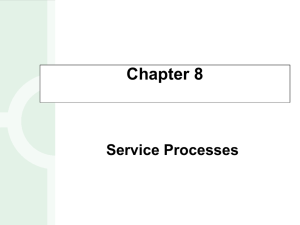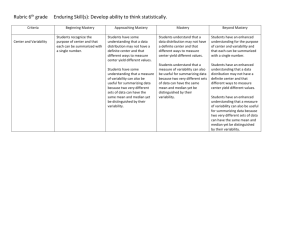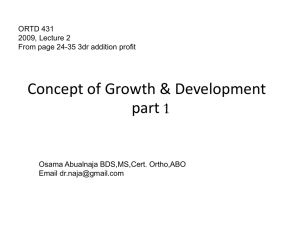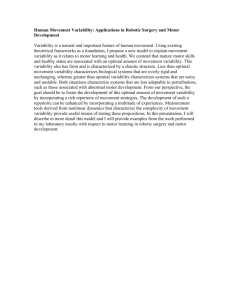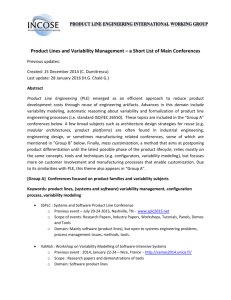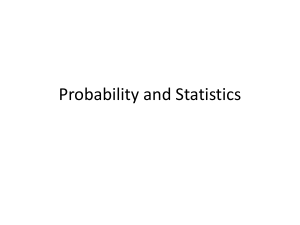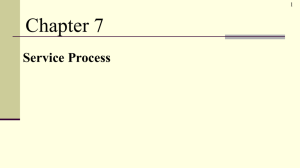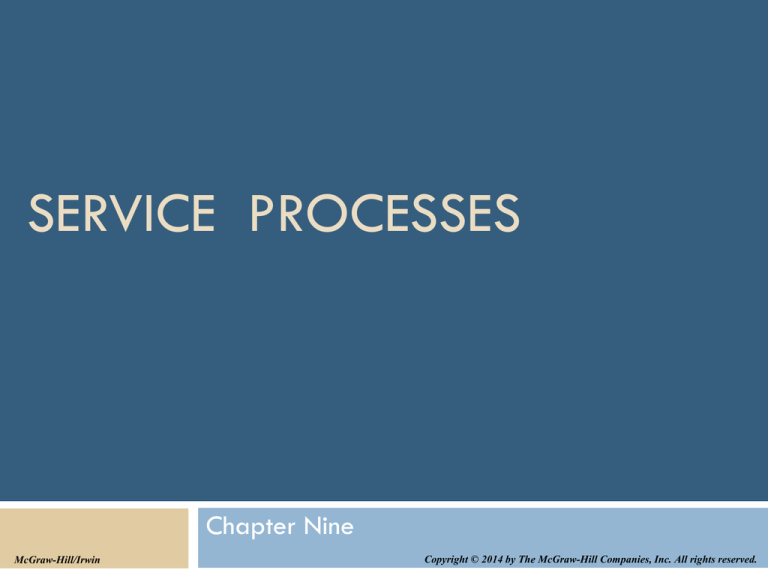
SERVICE PROCESSES
Chapter Nine
McGraw-Hill/Irwin
Copyright © 2014 by The McGraw-Hill Companies, Inc. All rights reserved.
Learning Objectives
LO9–1: Understand the characteristics of service
processes.
LO9–2: Explain how service systems are organized.
LO9–3: Analyze simple service systems.
LO9–4: Contrast different service designs.
9-2
The Nature of Services
The customer is the focal point of all decisions and
actions.
The organization exists to serve the customer.
Operations is responsible for service systems.
Operations is also responsible for managing the
work of the service workforce.
9-3
The Service Triangle
9-4
Service Package
1.
Supporting facility
2.
Facilitating goods
3.
Data provided by the customer
Explicit services
5.
The material purchased by the buyer or the items provided to the
customer
Information
4.
The physical resources that must be in place before a service can
be offered
Benefits that are observable by the senses
Implicit services
Psychological benefits the customer may sense only vaguely
9-5
An Operational Classification of
Services
Customer contact: the physical presence of the
customer in the system
Extent
of contact: the percentage of time the customer
must be in the system relative to service time
Services with a high degree of customer contact are
more difficult to control
Creation of the service: the work process involved
in providing the service itself
9-6
Major Differences between High- and
Low-Contact Systems in a Bank
9-7
Designing Service Organizations
Cannot inventory services.
Must
meet demand as it arises.
Service capacity is a dominant issue.
“What
capacity should I aim for?”
Marketing can adjust demand.
Cannot separate the operations management
function from marketing in services.
Waiting lines can also help with capacity.
9-8
How Service Design Is Different from
Product Design?
1.
The process and the product must be developed
simultaneously.
2.
3.
4.
5.
The process is the product.
A service operation lacks the legal protection commonly
available to products.
The service package constitutes the major output of the
development process.
Many parts of the service package are defined by the
training individuals receive.
Many service organizations can change their service
offerings virtually overnight.
9-9
Structuring the Service Encounter:
Service-System Design Matrix
Service encounters can be configured in a number of
different ways.
1.
2.
3.
4.
5.
6.
Mail contact
Internet and on-site technology
Phone contact
Face-to-face tight specs
Face-to-face loose specs
Face-to-face total customization
Production efficiency decreases with more customer
contact.
Low contact allows the system to work more efficiently.
9-10
Service-System Design Matrix
9-11
Characteristics Relative to the Degree
of Customer/Service Contact
9-12
Strategic Uses of the Matrix
1.
2.
3.
4.
Enabling systematic integration of operations and
marketing strategy
Clarifying exactly which combination of service
delivery the firm is providing
Permitting comparison of how other firms deliver
specific services
Indicating life cycle changes as the firm grows
9-13
Virtual Service: The New Role of the
Customer
Customers no longer just interact with the business.
Pure virtual customer contact: customers interact in an open
environment.
eBay
SecondLife
Mixed virtual and actual customer contact: customers
interact with one another in a server-moderated
environment.
YouTube
Wikipedia
9-14
Service Fail-Safing Poka-Yokes (A
Proactive Approach)
Poka-yokes: procedures that block a mistake from
becoming a service defect
Common in factories
Many applications in services
Warning methods
Physical or visual contact methods
Three T’s
1.
2.
3.
Task to be done
Treatment accorded to the customer
Tangible features of the service
Must often fail-safe actions of the customer as well as the
service workers
9-15
Three Contrasting Service Designs
1.
The production line approach (McDonald’s)
2.
The self-service approach (ATM machines)
3.
Service delivery is treated much like manufacturing.
Customer takes a greater role in the production of
the service.
The personal attention approach (Ritz-Carlton
Hotel Company)
9-16
Managing Customer-Introduced
Variability
How should services accommodate the variation
introduced by the customer?
Standard approach is to treat this as a trade-off
between cost and quality.
accommodation → more cost
Less accommodation → less satisfaction
More
Standard approach may overlook ways to
accommodate customer.
9-17
Five Types of Variability
1.
Arrival variability
2.
Request variability
3.
A patient being unable to explain symptoms to doctor
Effort variability
5.
Travelers requesting a room with a view
Capability variability
4.
Customers arriving at times when there are not enough service
providers
Shoppers not putting up carts
Subjective preference variability
Interpreting service action differently
9-18
Strategies for Managing CustomerIntroduced Variability
9-19
Applying Behavioral Science to Service
Encounters
1.
2.
3.
4.
5.
6.
The front-end and back-end of the encounter are
not created equal.
Segment the pleasure, combine the pain.
Let the customer control the process.
Pay attention to norms and rituals.
People are easier to blame than systems.
Let the punishment fit the crime in service recovery.
9-20
Service Guarantees as Design Drivers
1.
2.
3.
4.
5.
Any guarantee is better than no guarantee.
Involve the customer as well as employees in the
design.
Avoid complexity or legalistic language.
Do not quibble or wriggle when a customer
invokes a guarantee.
Make it clear that you are happy for customers to
invoke the guarantee.
9-21
Service Blueprinting and Fail-Safing
The standard tool for service process design is the
flowchart.
May
be called a service blueprint
A unique feature is the distinction between high
customer contact aspects of the service and those
activities the customer does not see.
Made
by a “line of visibility”
9-22
Example: Blueprint of a Typical
Automobile Service Operations
9-23
Seven Characteristics of a WellDesigned Service System
1.
2.
3.
4.
5.
6.
7.
Each element of the service system is consistent with the
operating focus of the firm.
It is user-friendly.
It is robust.
It is structured so that consistent performance by its people
and systems is easily maintained.
It provides effective links between the back office and the
front office.
It manages evidence of service quality so that customers
see the value of service provided.
It is cost-effective.
9-24




